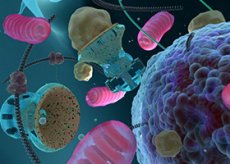Nanobiotechnology will be used to treat microbial infections
Last reviewed: 16.10.2021

All iLive content is medically reviewed or fact checked to ensure as much factual accuracy as possible.
We have strict sourcing guidelines and only link to reputable media sites, academic research institutions and, whenever possible, medically peer reviewed studies. Note that the numbers in parentheses ([1], [2], etc.) are clickable links to these studies.
If you feel that any of our content is inaccurate, out-of-date, or otherwise questionable, please select it and press Ctrl + Enter.

Nanotechnology was pleased with another discovery: this time, scientists pointed to the possibility of using microrobots and micromotors to eliminate microbial infections in the digestive tract. Micromotors have dimensions not exceeding half the thickness of a human hair. They are able to move around the mucous surface of the stomach and neutralize excess acid, after which the nanobioelectrode isolates an antibiotic that destroys the Helicobacter bacteria. The main developers of the project are Dr. Nanotechnologist Joseph Wang and Professor Liangfan Zhang, representing the Jacobs College of Engineering (University of California-San Diego). The researchers were able to "force" the micromotor to move inside the body and, if necessary, to allocate medicines. According to scientists, the technique will be the main one for the new era of treatment of gastrointestinal diseases. Previously, most of the drugs injected into the stomach were neutralized in an acidic environment. Now, in the digestive system, you can easily inject antibiotics, as well as enzymatic or protein preparations. To create protection for the medication administered, previously physicians used a specific acid-resistant coating for the drugs. And to reduce the effect of acid, proton pump inhibitor substances (for example, all known Omega and Omeprazole) were used. But such methods of treatment were not always reliable. In addition, this treatment was lengthy, expensive, and was accompanied by a large number of adverse events. With the use of nanotechnology, it became possible to deliver the medicine to its intended purpose and simultaneously "prepare the soil" for its effective treatment. Micromotors penetrate into the stomach cavity, stabilize the level of acidity to the required values, and only then release the drug. "All ingenious is simple. The antimicrobial drug will do its job without being damaged by the acidic environment. Now everything is solved simultaneously: there is no need for a phased long-term treatment. The medicine acts simply and reliably, "explains the scientist Bertha Esteban Fernandez de Avila. As explained by the project leaders, each microrobot and micromotor has a spherical magnesium core, clad in a titanium dioxide-based protector. Under the tread a dose of antibacterial preparation clarithromycin is hidden, which is released only when a certain acidity index of the medium is reached. The last surface layer of the nanoparticle is chitosan, the function of which is to hold the micromotor at the walls of the stomach. After the start of the acid neutralizer, microgases of hydrogen are released: they, in turn, are an additional pushing force for the micromotor. Further intragastric acidity is normalized, an antibiotic is released. The micromotor has a biodegradable structure and does not pose a danger to the patient. The rodent experiment has already shown excellent results. Presumably, according to scientists, soon nanopreparations will be able to completely replace the traditional drug treatment of stomach diseases.
 [1], [2], [3], [4], [5], [6], [7], [8], [9], [10], [11], [12], [13]
[1], [2], [3], [4], [5], [6], [7], [8], [9], [10], [11], [12], [13]
